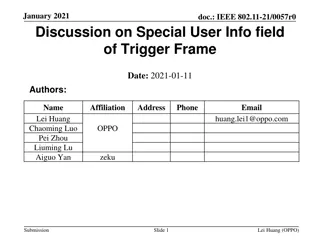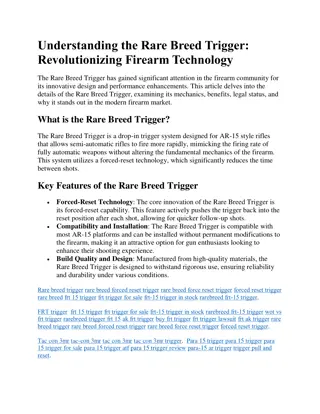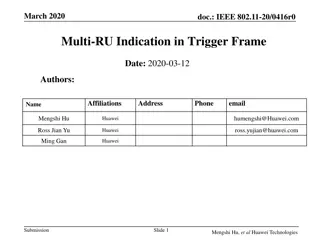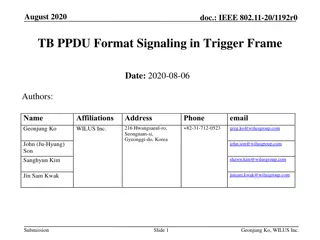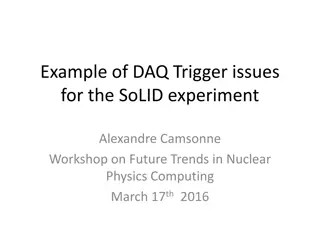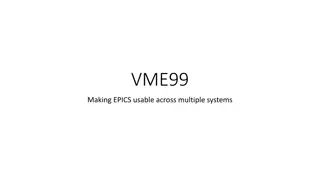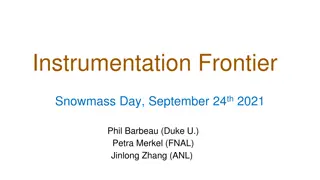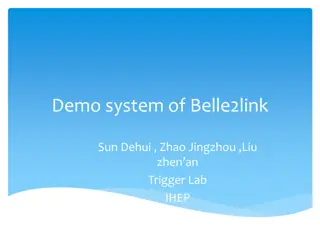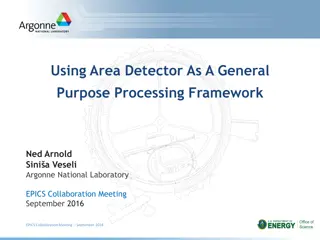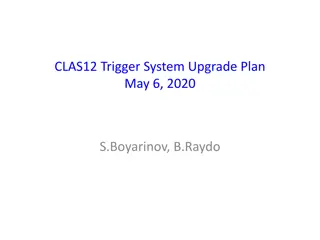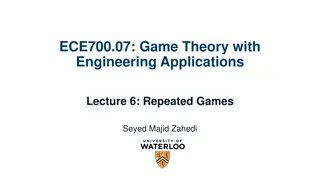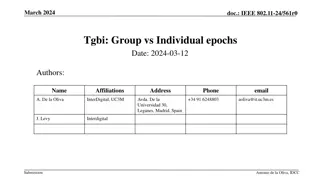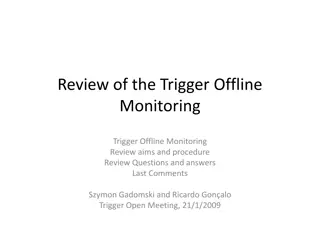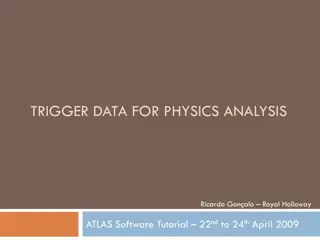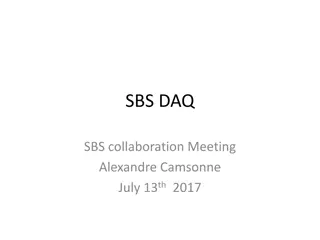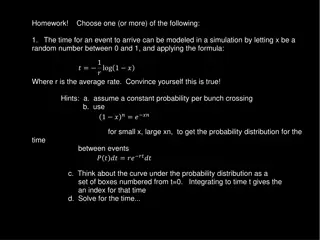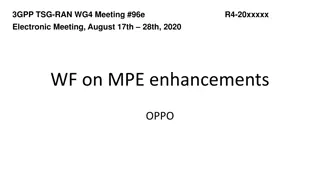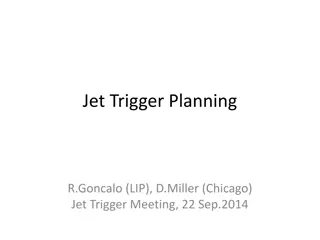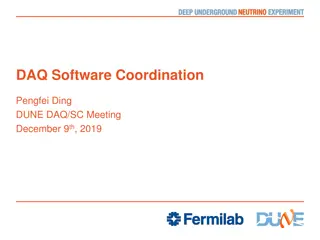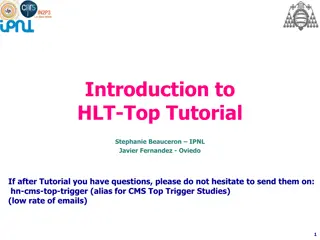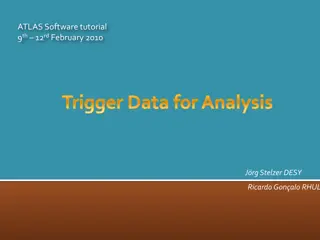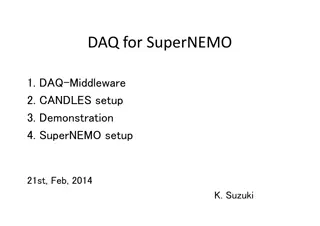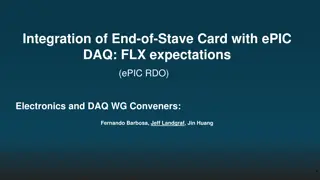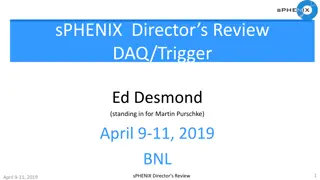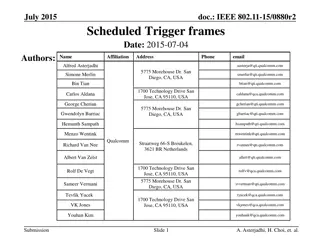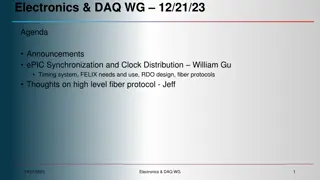Snaps and Hooks at Buckles International
Snap hooks, engineered with diverse specifications, offer multipurpose applicability and are available in various designs such as swivel snaps, bolt snaps, lobster snaps, claw clasp trigger snaps, and push trigger snaps.
0 views • 7 slides
IEEE 802.11-21/0057r0: Special User Info Field Discussion
The discussion revolves around the Special User Info field introduced in enhanced Trigger frames, detailing its main usages and implications in different frame types. There are proposals to optimize the structure of the MU-RTS Trigger frame by relocating certain subfields to reduce overhead and enha
0 views • 8 slides
Designing 9-Bit RU Allocation Subfield for EHT Trigger Frame in IEEE 802.11-20
IEEE 802.11-20/1845r2 presents a proposal for enhancing the RU allocation subfield design in the EHT Trigger frame to accommodate bandwidth support up to 320MHz and multiple RU or MRU allocations for UL MU transmissions in the 11be standard. The modification addresses inconsistencies in MRU mapping
0 views • 34 slides
Comparison of Trigger-based vs. Non-Trigger-based Sensing Measurement in IEEE 802.11
The document discusses the differences between Trigger-based (TB) and Non-Trigger-based (Non-TB) sensing measurement instances in IEEE 802.11 standards, focusing on who initiates the sensing measurement. TB sensing is initiated by the AP, while Non-TB sensing is initiated by a non-AP STA, enabling o
6 views • 13 slides
RAREBREEDTRIGGERSTORE
The Rare Breed Trigger has gained significant attention in the firearm community for its innovative design and performance enhancements. This article delves into the details of the Rare Breed Trigger, examining its mechanics, benefits, legal status,
24 views • 3 slides
Multi-RU Indication in Trigger Frame for IEEE 802.11
This document discusses the concept of Multi-RU (Resource Unit) allocation in trigger frames for IEEE 802.11 standards, specifically focusing on the indication methods within trigger frames for improved spectral efficiency. The proposal suggests various options for indicating multiple RUs in trigger
0 views • 14 slides
IEEE 802.11-20/1192r0 TB PPDU Format Signaling in Trigger Frame
The document discusses the need for a clear rule to determine the TB PPDU format for MU operations in IEEE 802.11 standards. It proposes methods to indicate the TB PPDU format in Trigger frames to avoid conflicts between different station types. Various signaling methods are suggested to differentia
0 views • 14 slides
Spatial Stream Allocation in IEEE 802.11-20 Trigger Frames
The document discusses spatial stream allocation in IEEE 802.11-20 trigger frames, specifically focusing on the SS Allocation subfield. It explains how trigger frames allocate resources for TB PPDU transmissions and solicit User Info fields, detailing the RU Allocation and SS Allocation subfields. T
3 views • 15 slides
Understanding DAQ Trigger Issues in SoLID Experiment
Explore DAQ trigger challenges faced in the SoLID experiment through examples, including trigger goals, data readout specifics, and experiment setups. Learn about managing high luminosity, reducing data rates, improving signal quality, and handling bottleneck issues for effective data acquisition. D
0 views • 22 slides
Closeout Report: Incremental Design Review of EIC Detector Electronics
Closeout report detailing the progress of the Incremental Preliminary Design and Safety Review of the EIC Detector DAQ and Electronics, along with the Final Design Review of Electronics Components for the ePIC Detector. The report includes responses to charge questions, panel reviews, comments, reco
0 views • 23 slides
Challenges and Solutions in Using EPICS for Digital DAQ Systems
Digital DAQ systems based on EPICS face issues with version control, data reading, trigger handling, and GUI consistency. Solutions involve code optimization, improving trigger management, and enhancing GUI design for better user experience.
2 views • 5 slides
CSC8503 Revision Lecture Overview - Exam Key Features and 2015/16 Exam Questions
Discussion of key features of the paper, review of last year's questions, exam details, and analysis of 2015/16 exam question 1. Detailed exploration of elements like Finite State Machines (FSM), states, transitions, trigger conditions, and specific details on the number of states, connections, and
2 views • 28 slides
Latest Updates on Instrumentation Frontier Activities - September 2021
Instrumentation Frontier activities are picking up pace after the pause in early 2021. Various groups are resuming meetings and workshops, with plans for White Paper kick-off and wrap-up workshops in the coming months. Each subgroup is organizing and categorizing LOIs to drive progress in Quantum Se
0 views • 13 slides
Overview of Belle2Link System
Belle2Link is a unified high-speed link connecting Front-End Electronics, Trigger, and DAQ systems for signal and data transmission. The system features unification in hardware, firmware, electrical isolation, and high-speed transmission rates. The demo system showcases hardware components like COPP
0 views • 21 slides
Implementing Data Acquisition System Using Area Detector as General Processing Framework
The data acquisition system discussed in this content utilizes the Area Detector framework as a versatile processing tool for handling data from various technical subsystems. It covers aspects such as DAQ architecture, high-speed data transfer methods, time-correlated data collection, and usage of A
0 views • 8 slides
CLAS12 Trigger System Upgrade Plan May 6, 2020
CLAS12 Trigger System is undergoing an upgrade to enhance trigger efficiency, purity, and data rate reduction. The existing hardware and trigger overview provide insight into the current system's components and operation. The upgrade goals aim to maintain high trigger efficiency, reduce data rates,
0 views • 14 slides
Overview of GRANDproto Project Workshop on Autonomous Radio Detection
GRANDproto project workshop held in May 2017 focused on improving autonomous radio detection efficiency for the detection of extensive air showers (EAS). Issues such as detector stability and background rates were discussed, with the goal of establishing radio detection as a reliable method for EAS
1 views • 14 slides
Game Theory with Engineering Applications: Repeated Games
Delve into the intricacies of repeated games in game theory, including finitely and infinitely repeated games with and without perfect monitoring, trigger strategies, and folk theorems. Explore the concept of subgame perfect equilibrium (SPE) in finitely repeated games through examples like the Pris
0 views • 27 slides
Experimental Data Analysis Report
This report covers various aspects of experimental data analysis at the research facility, including the status of INGRID, DAQ, neutrino event rate, beam center stability, event timing, and a general summary with visual representations. The efficiency of data taking, delivery and recording of spills
0 views • 6 slides
Discussion on IEEE 802.11 Group vs. Individual Epochs
Trigger discussion on differences between group and individual epochs in IEEE 802.11 standards. Group epochs involve simultaneous transitions of MAC parameters by all or selected STAs based on AP trigger, while individual epochs allow each STA to independently change its parameters. Key points inclu
0 views • 4 slides
Review of Trigger Offline Monitoring - Aims, Procedure, and Recommendations
The review of Trigger Offline Monitoring focuses on organizing shifts, improving documentation, and enhancing information flow. It outlines key questions and procedures to identify necessary improvements, formalize roles, and estimate resource needs. The review aims to optimize the monitoring infras
0 views • 18 slides
Overview of Front-End DAQ for TREND
Cutting-edge Front-End DAQ system featuring components like the Texas Instruments ADS6424 ADC, ALTERA 5CEFA4F23C6N FPGA, Ring Buffer for data management, u-blox Precision Timing GPS module for accurate time stamping, and General Slow Control Architecture for monitoring. The system utilizes Ethernet
0 views • 15 slides
Understanding Trigger Data Analysis in Physics: ATLAS Software Tutorial
This content provides detailed information on trigger data analysis for physics, focusing on ATLAS software tutorials conducted by Ricardo Gonçalo at Royal Holloway in April 2009. It covers features extraction algorithms, trigger configuration and data management, trigger-aware analysis, and the Tr
0 views • 26 slides
LV Trigger Cable Polish & EDH Order - Technical Details & Pricing
Explore technical specifications and pricing details of LV Trigger Cable Polish and EDH Order of August 2005. Uncover information on cable types, specifications, and pricing per meter for a 10km length. View images for a visual reference.
0 views • 5 slides
SoLID Collaboration Meeting Summary - June 8th, 2020
Outline of the SoLID collaboration meeting discussing DAQ requirements, trigger rates, infrastructure, and R&D items. Details on detector layouts and triggers for PVDIS and SIDIS, with information on SoLID requirements and associated risks. SoLID DAQ overview based on 12 GeV FADC electronics. Discus
0 views • 35 slides
SuperBigbite Collaboration Meeting Summary on DAQ and Electronics Progress
SuperBigbite collaboration meeting between Alexandre Camsonne and team took place on July 13th, 2017, discussing various topics such as data reduction, network upgrades, DAQ disks, and more. Detailed discussions on expected trigger rates, GEM occupancy, data rates, front tracker layout, and trackers
0 views • 31 slides
Modeling Event Arrival Time in Simulation
Exploring the simulation modeling of event arrival time using a random number formula and understanding the implications through probability distributions and time calculations. Additionally, analyzing small event simulations in STAR DAQ TPC DAQ and discussing data transfer modeling, as well as divi
0 views • 4 slides
Organizing DAQ and Operational Spaces for ProtoDUNE Project
In the context of the ProtoDUNE project, the organization of DAQ and operational spaces is crucial for efficient functioning. The initial installation at CERN faced challenges, prompting the need for remote control capabilities. The setup at SURF requires a thoughtful layout to accommodate key subsy
0 views • 8 slides
3GPP TSG-RAN-WG4 Meeting #96e Electronic Meeting August 17th-28th, 2020
This document discusses various topics related to PMPR reporting values, absolute and relative PMPR trigger thresholds, and the relationship between them. It covers agreements reached on defining reporting values, trigger thresholds, and configurations for event-triggered reporting scenarios within
0 views • 8 slides
Progress Report on Jet Trigger Planning and Monitoring Discussion
Highlights from a meeting discussing Jet Trigger Planning, Monitoring, Menu Evolution, and other related activities within the scientific community, emphasizing the need for strategic menu choices, migration to xAOD, menu awareness, full-scan implications, and ongoing software development efforts fo
0 views • 5 slides
Desired Features of a Software Build System for DUNE DAQ
Discussion on the desired features of a software build system for DUNE DAQ, including creating C++ builds, supporting multiple languages, handling multiple software versions, efficient change management, easy installation processes, modularity, and more. The aim is to streamline the software develop
0 views • 9 slides
Understanding CMS High Level Trigger Tutorial
Dive into the world of CMS High-Level Trigger system with this tutorial covering topics such as trigger constraints, HLT menu/path, hardware and software components, decision processes, and event recording. Explore the functionality of Level 1 triggering, High-Level Trigger streams, and the intricat
0 views • 21 slides
Optimal Early Drought Detection Using Stochastic Process
Explore an optimal stopping approach for early drought detection, focusing on setting trigger levels based on precipitation measures. The goal is to determine the best time to send humanitarian aid by maximizing expected rewards and minimizing expected costs through suitable gain/risk functions. Tas
0 views • 4 slides
Understanding ATLAS Software Tutorial on Trigger Data Analysis
This content delves into the significance and process of trigger data analysis in the context of ATLAS software tutorials. It covers topics such as Trigger Execution, Trigger Configuration, and Trigger-Aware Analysis, providing detailed insights into how triggers are configured, data is prepared, an
0 views • 37 slides
Overview of Data Acquisition Middleware for SuperNEMO
Data Acquisition Middleware (DAQ) plays a crucial role in managing data flow within the SuperNEMO setup. This includes components like source and sink ports, event managers, loggers, and monitors. The DAQ Middleware state machine controls the configuration, running, and pausing of the DAQ system. Ad
0 views • 12 slides
Integration of End-of-Stave Card with ePIC DAQ: FLX Expectations
In the realm of detector electronics, the integration of the End-of-Stave Card with ePIC DAQ is explored extensively through the FLX expectations set by the Electronics and DAQ Working Group. This integration involves various components such as the Global Timing Unit (GTU), Collider interfaces, Run
0 views • 10 slides
sPHENIX DAQ/Trigger System Overview
The sPHENIX DAQ/Trigger system is the focus of this review, covering the hardware, procurements, technical status, and deliverables of the system. Key components include Data Collection Modules (DCM-II), SubEvent Buffers (SEB), control machines, and global level 1 system. The system aims to achieve
0 views • 21 slides
Trigger Finger Treatment in Koramangala & Sarjapur Road, Bangalore_ Expert Care for Bone & Joint Health
If you're dealing with the discomfort of trigger finger, don't wait for the condition to worsen. Seeking prompt medical care from a bone and joint specialist in Koramangala or Sarjapur Road, Bangalore, will ensure that you receive the best treatment
1 views • 3 slides
IEEE 802.11-15/0880r2 Scheduled Trigger Frames - July 2015
This document from July 2015 discusses the IEEE 802.11-15/0880r2 Scheduled Trigger Frames, featuring various authors from Qualcomm, LG Electronics, Intel, Marvell, Broadcom, and Mediatek. The document includes multiple submission slides with contact information for the authors.
0 views • 17 slides
Electronics & DAQ Working Group Meeting Updates
The Electronics & DAQ WG meeting covered topics such as ePIC synchronization, clock distribution, FELIX system requirements, RDO design, and fiber protocols. Discussions included high-level fiber protocol considerations and upcoming collaboration meetings to address issues related to rates, ASICs, a
0 views • 10 slides

